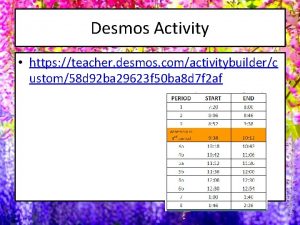USING DESMOS TO TEACH AND LEARN THE STANDARD








- Slides: 8

USING DESMOS TO TEACH AND LEARN THE STANDARD NORMAL CURVE Matthew T. Coignet | Glendale (AZ) Community College

Normal Distributions Many natural phenomena produce normal distributions which can be approximated by bell-shaped curves called normal curves. Every normal curve has the following properties: 1. Its peak occurs directly over the mean. 2. The curve is symmetric about the vertical line through the mean. 3. The curve never touches the x-axis, as it continues indefinitely in both directions. 4. The area between the curve and the horizonal axis is always exactly 1.

Example 1 The table at right provides the total annual rainfall (in mm) at the Cairns, QLD (Australia) International Airport between 1943 and 2017. Use Desmos to find the mean and standard deviation. https: //www. desmos. com/calculator/qosvvfdbhb

Example 2 https: //www. desmos. com/calculator/imvusmhmlw Use Desmos to create a normal curve for the rainfall data in Example 1. Then, find the percentage of years that Cairns recorded rainfall: a. between 2000 mm and 3000 mm. b. less than 900 mm. c. greater than 1550 mm. d. less than the mean. e. within 1 standard deviation of the mean. f. within 2 standard deviations of the mean. g. within 3 standard deviations of the mean. h. within 1. 25 standard deviations of the mean.

Example 3 https: //www. desmos. com/calculator/llf 4 k 0 aqqv Continuing with our Cairns rainfall data in Example 1, find the amount of rainfall associated with each of the following percentiles: a. 33 rd percentile. b. 40 th percentile. c. 50 th percentile. d. 67 th percentile. e. 87. 5 th percentile. f. 94 th percentile.

Example 4 (Your Turn) Global solar exposure (GSE) is the total amount of solar energy falling on a horizontal surface. The daily global solar exposure is the total solar energy for a day. Typical values for daily global solar exposure range from 1 to 35 MJ/m² (megajoules per square meter). The values are usually highest in clear sunny conditions during the summer and are usually lowest during winter or very cloudy days. The average GSE (in MJ/m²) in Brisbane (Australia) city for each of the years between 1990 and 2019 is provided in this Desmos: https: //www. desmos. com/calculator/uxmspk 1 vyn a. Use Desmos to create a normal curve for the annual GSE. b. Find the percentage of years for which the annual GSE was between 18. 2 MJ/m² and 18. 7 MJ/m². c. Find the 25 th and 75 th percentiles of the annual GSE. d. Find the values of the annual GSE associated with the middle 68% of years.

Discussion Questions 1. Name one of your favorite real-world applications that you use to teach normal distributions. 2. What other resources have you used to teach normal distributions? 3. Do you think that you might like to use Desmos to teach normal distributions?

THANK YOU! https: //www. gccaz. edu/profile/matthew-coignet















